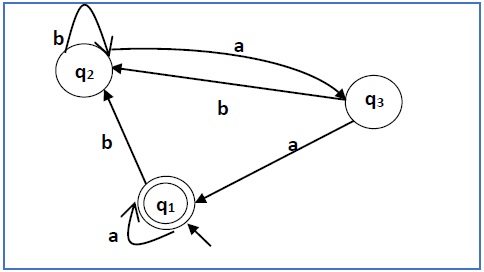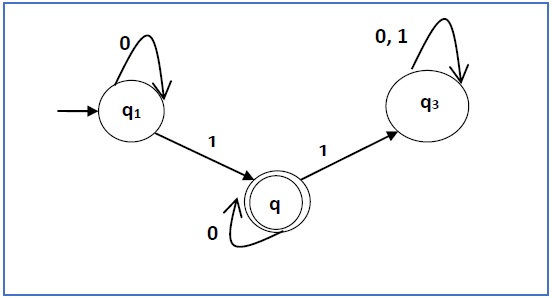Formal Languages and Automata Theory
1. NFA vs DFA
The theory of computation is a branch of computer science that deals with how problems are solved using algorithms. It has three
branches, namely; the computational complexity theory, the
computability theory, and the automaton theory.
The automaton or automata theory is the
study of abstract mathematical machines or systems that can be used to
solve computational problems. An automaton is made up of states and
transitions, and as it sees a symbol or letter of input, it makes a
transition to another state taking the current state and symbol as
input.
The automaton or automata theory has
several classes that include the Deterministic Finite Automata (DFA) and
the Nondeterministic Finite Automata (NFA). These two classes are
transition functions of automata or automaton.
In transition, DFA cannot use n empty
string, and it can be understood as one machine. If the string ends at a
state that is not an acceptable state, DFA will reject it. A DFA
machine can be constructed with every input and output.
DFA only has one state transition for
every symbol of the alphabet, and there is only one final state for its
transition which means that for each character that is read, there is
one corresponding state in DFA. It is easier to check membership in DFA
but it is more difficult to construct. Backtracking is allowed in DFA,
and it requires more space than NFA.
Backtracking is not always allowed in
NFA. While it is possible in some cases, in others it is not. It is
easier to construct NFA, and it also requires less space, but it is not
possible to construct an NFA machine for every input and output.
It is understood as several tiny machines
that compute simultaneously, and membership can be harder to check. It
uses Empty String Transition, and there are numerous possible next
states for each pair of state and input symbol. It starts at a specific
state and reads the symbols, and the automaton then determines the next
state which depends on the current input and other consequent events.
At its accepting state, NFA accepts the string and rejects it otherwise.
Summary:
1.“DFA” stands for “Deterministic Finite Automata” while “NFA” stands for “Nondeterministic Finite Automata.”
2.Both are transition functions of automata. In DFA the next possible state is distinctly set while in NFA each pair of state and input symbol can have many possible next states.
3.NFA can use empty string transition while DFA cannot use empty string transition.
4.NFA is easier to construct while it is more difficult to construct DFA.
5.Backtracking is allowed in DFA while in NFA it may or may not be allowed.
6.DFA requires more space while NFA requires less space.
7.While DFA can be understood as one machine and a DFA machine can be constructed for every input and output, 8.NFA can be understood as several little machines that compute together, and there is no possibility of constructing an NFA machine for every input and output.
2.Both are transition functions of automata. In DFA the next possible state is distinctly set while in NFA each pair of state and input symbol can have many possible next states.
3.NFA can use empty string transition while DFA cannot use empty string transition.
4.NFA is easier to construct while it is more difficult to construct DFA.
5.Backtracking is allowed in DFA while in NFA it may or may not be allowed.
6.DFA requires more space while NFA requires less space.
7.While DFA can be understood as one machine and a DFA machine can be constructed for every input and output, 8.NFA can be understood as several little machines that compute together, and there is no possibility of constructing an NFA machine for every input and output.
Difference between Mealy and Moore machines
Mealy Machine – A mealy machine is defined as a machine
in theory of computation whose output values are determined by both its
current state and current inputs. In this machine atmost one transition
is possible.
It has 6 tuples: (Q, q0, ∑, O, δ, λ’)
Q is finite set of states
q0 is the initial state
∑ is the input alphabet
O is the output alphabet
δ is transition function which maps Q×∑ → Q
‘λ’ is the output function which maps Q×∑→ O
It has 6 tuples: (Q, q0, ∑, O, δ, λ’)
Q is finite set of states
q0 is the initial state
∑ is the input alphabet
O is the output alphabet
δ is transition function which maps Q×∑ → Q
‘λ’ is the output function which maps Q×∑→ O

Moore Machine – A moore machine is defined as a machine in theory of computation whose output values are determined only by its current state.
It has also 6 tuples: (Q, q0, ∑, O, δ, λ)
Q is finite set of states
q0 is the initial state
∑ is the input alphabet
O is the output alphabet
δ is transition function which maps Q×∑ → Q
λ is the output function which maps Q → O
Diagram –

Moore Machine –
- Output depends only upon present state.
- If input changes, output does not change.
- More number of states are required.
- There is more hardware requirement.
- They react slower to inputs(One clock cycle later)
- Synchronous output and state generation.
- Output is placed on states.
- Easy to design.
- Output depends on present state as well as present input.
- If input changes, output also changes.
- Less number of states are required.
- There is less hardware requirement.
- They react faster to inputs.
- Asynchronous output generation.
- Output is placed on transitions.
- It is difficult to design
Statement −
Let P and Q be two regular expressions.
If P does not contain null string, then R = Q + RP has a unique solution that is R = QP*
Proof −
R = Q + (Q + RP)P [After putting the value R = Q + RP]
= Q + QP + RPP
When we put the value of R recursively again and again, we get the following equation −
R = Q + QP + QP2 + QP3…..
R = Q (ε + P + P2 + P3 + …. )
R = QP* [As P* represents (ε + P + P2 + P3 + ….) ]
Hence, proved.Assumptions for Applying Arden’s Theorem
- The transition diagram must not have NULL transitions
- It must have only one initial state
Method
Step 1 − Create equations as the following form for all the states of the DFA having n states with initial state q1.
q1 = q1R11 + q2R21 + … + qnRn1 + ε
q2 = q1R12 + q2R22 + … + qnRn2
…………………………
…………………………
…………………………
…………………………
qn = q1R1n + q2R2n + … + qnRnn
Rij represents the set of labels of edges from qi to qj, if no such edge exists, then Rij = ∅Step 2 − Solve these equations to get the equation for the final state in terms of Rij
Problem
Construct a regular expression corresponding to the automata given below −
 Solution −
Solution −Here the initial state and final state is q1.
The equations for the three states q1, q2, and q3 are as follows −
q1 = q1a + q3a + ε (ε move is because q1 is the initial state0
q2 = q1b + q2b + q3b
q3 = q2a
Now, we will solve these three equations −
q2 = q1b + q2b + q3b
= q1b + q2b + (q2a)b (Substituting value of q3)
= q1b + q2(b + ab)
= q1b (b + ab)* (Applying Arden’s Theorem)
q1 = q1a + q3a + ε
= q1a + q2aa + ε (Substituting value of q3)
= q1a + q1b(b + ab*)aa + ε (Substituting value of q2)
= q1(a + b(b + ab)*aa) + ε
= ε (a+ b(b + ab)*aa)*
= (a + b(b + ab)*aa)*
Hence, the regular expression is (a + b(b + ab)*aa)*.Problem
Construct a regular expression corresponding to the automata given below −
 Solution −
Solution −Here the initial state is q1 and the final state is q2
Now we write down the equations −
q1 = q10 + ε
q2 = q11 + q20
q3 = q21 + q30 + q31
Now, we will solve these three equations −
q1 = ε0* [As, εR = R]
So, q1 = 0*
q2 = 0*1 + q20
So, q2 = 0*1(0)* [By Arden’s theorem]Hence, the regular expression is 0*10*.
Comments
Post a Comment